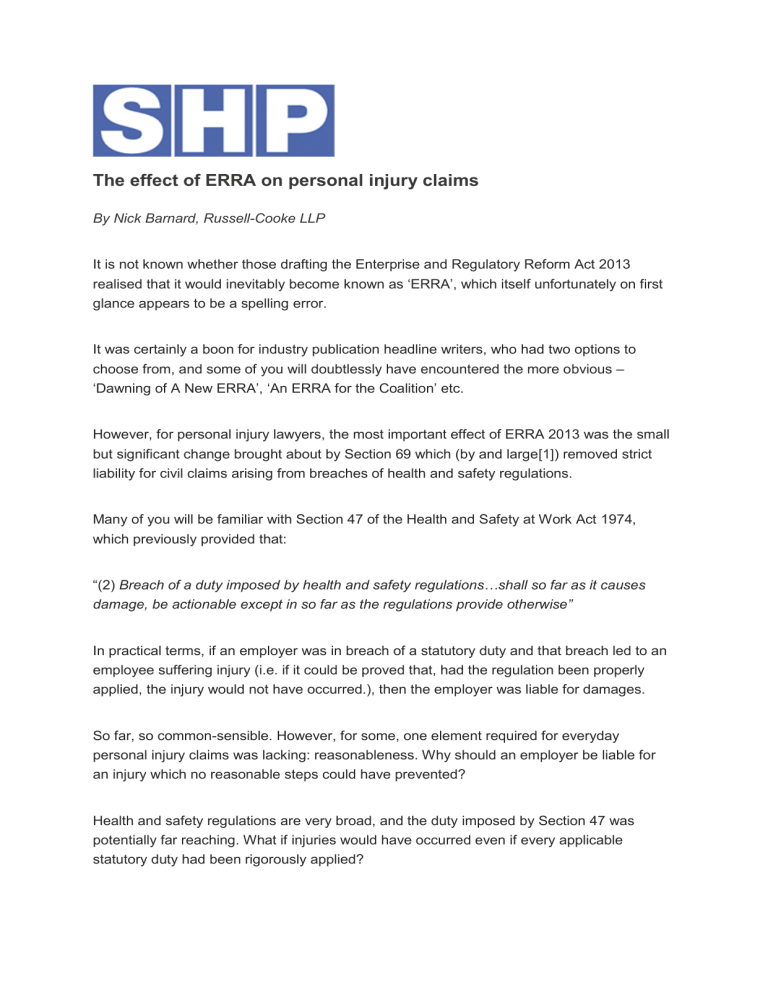The effect of ERRA on personal injury claims - Russell

The effect of ERRA on personal injury claims
By Nick Barnard, Russell-Cooke LLP
It is not known whether those drafting the Enterprise and Regulatory Reform Act 2013 realised that it would inevitably become known as ‘ERRA’, which itself unfortunately on first glance appears to be a spelling error.
It was certainly a boon for industry publication headline writers, who had two options to choose from, and some of you will doubtlessly have encountered the more obvious –
‘Dawning of A New ERRA’, ‘An ERRA for the Coalition’ etc.
However, for personal injury lawyers, the most important effect of ERRA 2013 was the small but significant change brought about by Section 69 which (by and large [1] ) removed strict liability for civil claims arising from breaches of health and safety regulations.
Many of you will be familiar with Section 47 of the Health and Safety at Work Act 1974, which previously provided that:
“(2) Breach of a duty imposed by health and safety regulations…shall so far as it causes damage, be actionable except in so far as the regulations provide otherwise”
In practical terms, if an employer was in breach of a statutory duty and that breach led to an employee suffering injury (i.e. if it could be proved that, had the regulation been properly applied, the injury would not have occurred.), then the employer was liable for damages.
So far, so common-sensible. However, for some, one element required for everyday personal injury claims was lacking: reasonableness. Why should an employer be liable for an injury which no reasonable steps could have prevented?
Health and safety regulations are very broad, and the duty imposed by Section 47 was potentially far reaching. What if injuries would have occurred even if every applicable statutory duty had been rigorously applied?
This was put to the test in Stark v Post Office [2000] EWCA Civ 64. Mr Stark, a postman, was provided with a bicycle by the Post Office for making his deliveries. One day in July
1994, Mr Stark’s front wheel locked and he was thrown over the handlebars, causing serious injuries. On investigation, it was established that the front brake stirrup had snapped in two and jammed the front wheel. The cause of the snapping was either metal fatigue or manufacturing defect, but the court concluded that no inspection (even a ‘vigorous’ one) would have identified the defect. Although the bicycle was 14 years old, the Post Office had done a reasonable job of inspecting it and passing it fit for service.
Nonetheless, Regulation 6(1) of the Provision and Use of Work Equipment Regulations 1992 states that:
“Every employer shall ensure that work equipment is maintained in an efficient state, in efficient working order and in good repair.”
When combined with the burden imposed by Section 47, the Court of Appeal decided that there was no escape for the Post Office. The Regulation required that the equipment be in efficient working order, regardless of the fact that only milliseconds may have passed between the defect becoming visible and the accident occurring. From the moment the stirrup snapped, the Post Office was in breach of Regulation 6(1) of PUWER 1992 and liable for the injuries which resulted.
For some, the (occasionally) unfair burden of Section 47 was a worthwhile trade-off to protect those who work in harm’s way. The Coalition were not so sure and following
Professor Ragnar Löfstedt’s 2011 review ‘Reclaiming Health and Safety For All’, Section 69 of ERRA 2013 amended Section 47 of HSWA 1974 to read:
(2) Breach of a duty imposed by a statutory instrument containing (whether alone or with other provision) health and safety regulations shall not be actionable except to the extent that regulations under this section so provide.
(2A) Breach of a duty imposed by an existing statutory provision shall not be actionable except to the extent that regulations under this section so provide (including by modifying any of the existing statutory provisions).
As a result, it is no longer sufficient to draw a dotted line between a breach of duty and an injury in order to establish civil liability (as if it was ever tha t simple…). Rather, claimants are now faced with the challenge at the heart of any other personal injury claim: proving
negligence. In particular, the claimant is obliged to show that the alleged failures constituted an unreasonable failure by his or her employer to protect them.
The Real World
How does Section 69 change the world? From the perspective of a claimant personal injury solicitor, the answer is not a great deal (yet).
The common law regarding employer’s duties to their employees to prevent personal injury is even broader than the statutory regime. Employers are expected to take reasonable steps to provide a safe place of work, competent employees, safe plant and equipment and a safe system of work. In most instances, it does not take a great stretch of the imagination to match a breach of one of the Regulations which have ‘gone missing’ from the personal injury lawyer’s arsenal to one of these four duties.
Health and safety regulations exist for a reason, and so it is seldom difficult to find a link between a failure to follow regulations and an employer who has failed to take reasonable care for the safety of their employee. When, for example, is it reasonable not to risk assess dangers? When is it reasonable not to keep workplace equipment in efficient working order and in good repair?
The first ‘marquee case’ on the application of Section 69 has yet to come to court, and so it may yet change the landscape. However, in the 21 months since the change came into effect, we have yet to encounter a case which would have been viable prior to October 2013, but is not today.
It would be condescending to say that Section 69 should not lead to complacency amongst safety and health practitioners. However, it would be right to say that it is unlikely that
Section 69 is going to make your life a great deal easier.
Your liability insurer is likely to expect more from you in the coming years. Cases which would previously have been conceded will be contested (at least to begin with), and your insurer will be relying on you to provide the evidence to show that you acted reasonably.
On a practical level, it would be advisable to get (and keep) your house in order when it comes to such evidence. One of the most common delays in progressing workplace claims is that the insurer is ‘waiting for documents from the client’. Failure to provide the evidence is likely to result in a swing in the claimant’s favour. Every missed deadline for providing evidence is a step closer to court and an increase in legal costs. Your insurer may forgive
the error which led to the injury, but sympathy may run short if you have increased costs through preventable delays. Conversely, if you have your risk assessments and related documents at your fingertips, then both you and your injured employee will benefit from the claim being resolved promptly.
In summary:
1. Statutory duties have not gone away. They still carry criminal sanctions, and are the first place claimant solicitors look when seeking to prove negligence.
2. Statutory duties can be your friend. One concern has been that if there is a perceived
‘easing’ of statutory regulation, then there may be an increase in accidents caused by a relaxation of attitudes towards safety. However, if you are confident that you have complied with all of your statutory duties then, even if an injury does occur, you are in a good position to show that you did all that was reasonable to prevent it (although this is not to say there are no risks which warrant a higher standard of precaution than imposed by statute
…).
Section 69 really only addresses the ‘problem’ of unusual cases like Mr Stark’s. As such, workplace injury claims overall are unlikely to decrease as a result, although of course it must be acknowledged that workplace injuries have been historically decreasing, in large part due to the impact of statutory duties.
1. There may be a grace period whilst the new law beds in, but you may find that, in time, as more claims are contested, your insurer places greater demands on you to prove that you took all reasonable steps – which can only be a good thing.
[1] Many commentators consider that, due to the ‘direct effect’ of European law, emanations of the state (which can include bodies such as private utility companies, as well as more obvious public service providers) retain an additional burden of complying directly with EC
Directives, not just UK legislation implementing those directives. Furthermore, that because the Employers Liability Defective Equipment Act 1969 has ‘survived’ ERRA 2013, employers remain liable for injuries caused by defective work equipment provided by third parties.
Nick Barnard is an associate solicitor in Personal Injury and Clinical Negligence at Russell-
Cooke LLP


